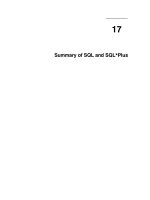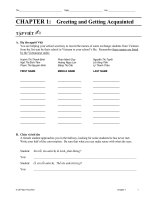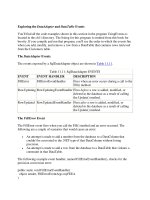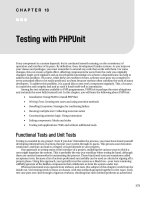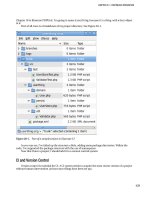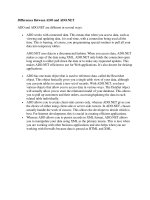Tài liệu Classes, Top-Level Classes, and Instances Basically docx
Bạn đang xem bản rút gọn của tài liệu. Xem và tải ngay bản đầy đủ của tài liệu tại đây (9.45 KB, 2 trang )
< Day Day Up >
Classes, Top-Level Classes, and Instances
Basically, a class is a definition or blueprint of how an object is made up and how it
should act. For example, an instance of the Array class (an Array object) can store
multiple pieces of information in numerically indexed locations (myArray[0],
myArray[1], myArray[2], and so on). How can the array do this? It knows how to do this
because it was defined that way by the Array class. The Array class has hidden logic and
definitions (code) that work behind the scenes to define the way an Array object works
and how it's used. Think of a class as a template from which objects are created. This is a
vague description of a class, but as you progress through this lesson and are introduced to
more concepts, terminology, and examples, you'll gain a better understanding of what a
class really is.
A class generally exists to produce an instance of itself on demand. You create an
instance of a class by invoking the constructor method of that class. For example:
var myArray:Array = new Array():
The action to the right of the equals sign, new Array() in this example, executes the
constructor method of the Array class. You cannot use the Array class directly. You must
create an instance of the class to use any of its properties and methods. When creating the
array instance, the Array class creates an object and then populates it with properties and
methods. In a sense, the Array class is similar to a factory for array objects. When asked,
it creates and returns an Array object.
There also are classes that you can use without the need to create an instance. This type
of a class is called a top-level class. Examples of this type of class include the Math,
Mouse, and Key classes. When you think about it, top-level classes make sense. Is there
ever really a need to have more than one instance of the Mouse class or the Math class?
With the Math class, you simply pass a number into a method and a result is returned.
The Math class doesn't store any of the information that you feed it, so only one copy is
needed. On the other hand, arrays store unique data, so it wouldn't make sense to access
the Array class directly because you would only be able to have one array.
TIP
Some programmers call a top-level class a singleton.
< Day Day Up >
